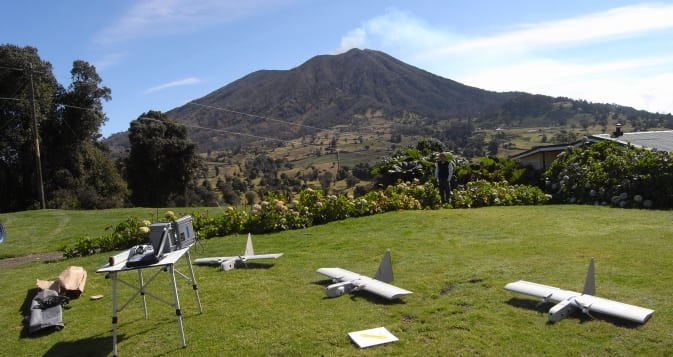0
0
1
219
1249
Accessintel
10
2
1466
14.0
Normal
0
false
false
false
EN-US
JA
X-NONE
/* Style Definitions */
table.MsoNormalTable
{mso-style-name:”Table Normal”;
mso-tstyle-rowband-size:0;
mso-tstyle-colband-size:0;
mso-style-noshow:yes;
mso-style-priority:99;
mso-style-parent:””;
mso-padding-alt:0in 5.4pt 0in 5.4pt;
mso-para-margin:0in;
mso-para-margin-bottom:.0001pt;
mso-pagination:widow-orphan;
font-size:12.0pt;
font-family:Cambria;
mso-ascii-font-family:Cambria;
mso-ascii-theme-font:minor-latin;
mso-hansi-font-family:Cambria;
mso-hansi-theme-font:minor-latin;}
NASA recently demonstrated another example of how unmanned aircraft systems (UAS) are used for civilian purposes, by launching AeroVironment’s Dragon Eye UAS into the San Jose, Costa Rica Turrialba Volcano’s sulfur dioxide plume to study its chemical environment.

(The three Dragon Eye unmanned aircraft systems used by NASA for the study. Photo, courtesy of NASA/Randy Berthold)
The “In Situ Validation and Calibration of Remotely Sensed Volcanic Emission Data and Models” study featured 10 flights between March 11-14. NASA said the project’s objectives were to improve satellite data research products, such as maps of concentration and distribution of volcanic gases and transport-pathway models of volcanic plumes.
“It is very difficult to gather data from within volcanic eruption columns and plumes because updraft wind speeds are very high and high ash concentrations can quickly destroy aircraft engines,” said David Pieri, a research scientist at NASA’s Jet Propulsion Lab (JPL).

(The study launched 10 flights into the volcanic plume along the rim of the Turrialba summit crater, approximately 10,500 feet above sea level. Photo, courtesy of Google.)
The Dragon Eye is a small electric UAS with a 3.75 foot wingspan and a one-pound instrument payload, with small electric motors that ingest little contaminated air which was a great match for NASA’s project objectives. NASA acquired three Dragon Eyes from the U.S. Marine Corps (USMC). USMC typically uses the Dragon Eye for “over-the-next-hill” tactical reconnaissance and surveillance, according to AeroVironment.
Computer models derived from the study will help to improve global climate predictions and mitigate environmental hazards for people who live near volcanoes.
Related: Unmanned Systems News
Follow @AvionicsMag